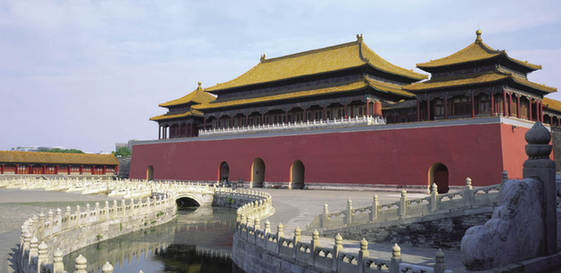| Remembering Beijing's Moat System
By HUO JIANYING
OVER the course of almost a millennium, Beijing served as the capital of four dynasties: the Jin (ruled by the Jurchens, 1115-1234), Yuan (the Mongol empire, 1271-1368), Ming (ruled by the Han Chinese, 1368-1644) and Qing (Manchu rule, 1644-1911). On any map of dynastic Beijing, one finds a blue line of water defining the city's outline – the square "Central Capital" of the Jin, the rectangular "Big Capital" of the Yuan and the T-shaped "Northern Capital" (Bei Jing) of the Ming and Qing dynasties. No matter how the city boundaries shifted from dynasty to dynasty, a blue-lined moat always traced the capital's edge. The moat's name has also remained constant throughout the centuries, literarily meaning "City-protecting River." A moat girding a walled city was typical of ancient Chinese urban construction, serving defensive purposes, as well as providing a water supply and drain.
 |
| The section of the moat inside the Forbidden City is known as the Inner Golden Water River. |
Inner and Outer Moats
Beijing's moat system was more complicated than those of other Chinese cities, as it comprised outer, inner and imperial moats. The Ming and Qing capital was encircled by four sets of walls, dividing the city into outer, inner, imperial and palatial (Forbidden City) sections, each of which had a moat. Only some sections of this system can still be seen today.
According to historical records, the outer and inner moats of the Ming Dynasty were 52 meters wide, five meters deep, and 20 meters from the foot of the city wall. Their vertical banks were formed by mortar-bonded granite blocks 50 centimeters thick and 70 centimeters across, topped at ground level by a low wall. Their moat beds were formed from rammed lime-earth. The two moats totaled about 41 kilometers in length.
The inner moat was dug when Emperor Yongle (reigned 1403-1424) rebuilt Beijing as the Ming capital. It roughly followed the course of the present-day Second Ring Road. The outer moat was an unfinished project launched by Emperor Jiajing (reigned 1521-1566). Since the Ming suffered frequent attacks by nomadic tribes, the emperor decided to build an outer city as a buffer zone. Construction started in 1550, but was soon suspended due to public resistance to mass destruction of civilian residences and shops. Construction resumed in 1553. According to the original plan, the outer wall would encompass the whole city and had 11 fortified gates and several water passes and sluice gates. Construction began in the south outside today's Zhengyangmen (Zhengyang Gate).
However, the project went no further as escalating frontier warfare and an accidental fire that damaged part of the Forbidden City forced the imperial court to concentrate its limited financial and material resources on national defense and reconstruction of the imperial palace. Seeing no other option, the cash-strapped builders extended the finished section of the scheduled outer city wall northward to join the inner wall, forming a rectangle and turning the shape of the walled city into the Chinese character 凸.
The main course of the outer moat, today known as the Southern Moat, is 22 to 45 meters wide and 15.5 kilometers long. It starts at Xibianmen and flows northward into the Tonghui River via Guangqumen, linking the Western Moat and Lotus River.
During the Ming and Qing dynasties, Beijing had plenty of water, and its Western Hills were noted for more than 30 springs which fed into the city via Kunming Lake and the Changhe and Gaoliang rivers. According to a survey conducted by the municipal geological department in the 1950s, Beijing had 1,347 springs in total.
|
